
PREV ARTICLE
NEXT ARTICLE
FULL ISSUE
PREV FULL ISSUE
SELECTIONS FROM HERITAGE 2016 ANA SALE
This week's Heritage Auctions ad features several selections from the firm's upcoming sale at the American Numismatic
Association's World's Fair of Money in Anaheim, CA. Here are some that caught my eye. Thanks to Denice Brackemyre at Heritage for
providing the lot numbers. -Editor
Lot 3937: 1796 Washington Dollar
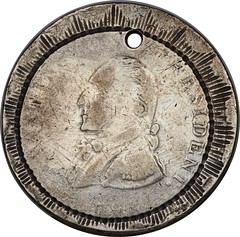 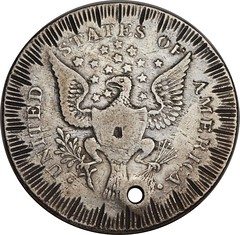
The Unique 1796 Washington Dollar, VG Details Struck Over Mexican 8 Reales
1796 MEDAL Washington "Dollar," Baker-33, Unique, Silver -- Damaged, Holed -- NGC Details. VG. 361.1 grains, 39.0 x 39.2 mm, specific gravity 10.4. Believed unique, this dollar-sized piece is struck over a Spanish 8 reales, likely from the Mexico City Mint. When James Ross Snowden published The Medallic Memorials of Washington in the Mint of the United States in 1861, he illustrated this piece on Plate XI. The Snowden plate shows the hole in exactly the same position, proving that this is the same piece. A little over a quarter century later, W.S. Baker described the piece in Medallic Portraits of Washington as his number 33. Baker noted that H. Drumheller of Schuylkill County, Pennsylvania was the owner of the piece in 1861, and that it was on loan to the Mint. Henry Drumheller was a merchant in North Mannheim, Schuylkill County, Pennsylvania in 1860. He was born in Pennsylvania about 1813. Although dated 1796, the obverse is virtually identical to the 1792 Washington President pieces by Peter Getz, using the same device punch for the uniformed George Washington, and the reverse is from the identical die that Getz used for his 1792 Washington pieces. The specific gravity of 10.4 approximates .950 fine silver. We believe that the obverse and reverse of the pillar dollar were planed down before this example was struck, although traces of undertype are still visible, especially at CA of AMERICA. The ornamental squares and circles edge is still clearly visible around most of the circumference. The obverse and reverse have borders of rays that were hand punched after this piece was struck. The scalloped circle on the obverse, also hand punched, marks the edge of the die. George Fuld and Eric P. Newman studied this piece at length in 1961, and they came to the conclusion that it is a medal, calling it a "development piece" that Getz used during the production of 1797 Masonic medals that also featured the likeness of George Washington. For their detailed report, see "Rediscovery of the 1796 Washington President Piece" in the April 1961 issue of The Colonial Newsletter.
Very intriguing piece with a long numismatic history. -Editor
To read the complete lot description, see:
Lot 3935: 1792 CENT Washington Getz President Pattern Cent, Plain Edge
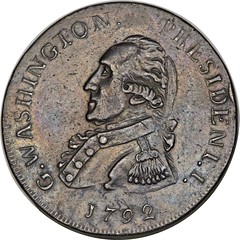 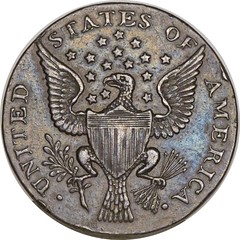
1792 CENT Washington Getz President Pattern Cent, Plain Edge, XF45 NGC. Baker-25, Breen-1352, Pollock-5020, W-10775, R.5. 257.7 grains, 33.2 mm. Just over 50 of these survive in copper from an unknown production that some numismatists estimate at 100 pieces. Peter Getz of Lancaster, Pennsylvania, just 23 years old at the time, "is said to have aspired to the position of Mint engraver" according to George Fuld in The Washington Pattern Coinage of Peter Getz. His design closely followed the language of a coinage bill that Robert Morris introduced to Congress on December 21, 1791. Meanwhile, Getz became a successful goldsmith and jeweler who operated a business on Queen Street, "opposite Mr. Slough's tavern" according to a contemporary advertisement. He died at the age of 36 in 1804. To read the complete lot description, see:
Lot 3939: Libertas Americana Medal
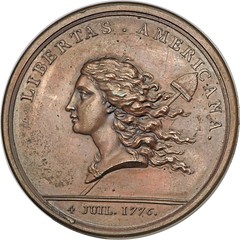 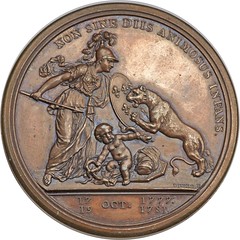
(1781) Libertas Americana Medal, Bronze, MS63 Brown NGC. Betts-615, Loubat-14. Augustin Dupre was arguably the best die engraver of the 18th century, certainly in France where these pieces were struck, and possibly anywhere in the world at the time. Designed after the concept of Benjamin Franklin, the beauty of this medal is equaled by its numismatic and historical importance. The Libertas Americana medal is considered one of the greatest medals ever produced, and it holds the number one position in 100 Greatest American Medals and Tokens, by Katherine Jaeger and Q. David Bowers. This spectacular example features chestnut and golden-brown surfaces with fully reflective fields and bold design elements. Delicate blue overtones complete the picture of a spectacular French medal telling the history of America.
Nice example of the iconic American medal. -Editor
To read the complete lot description, see:
Lot 3951: 1792 Silver Center Cent
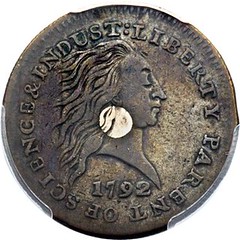 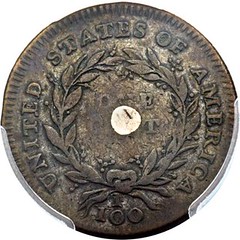
1792 Silver Center Cent, Judd-1, SP35
1792 P1C One Cent, Judd-1, Pollock-1, High R.6 SP35 PCGS Secure. CAC. The Silver Center cent is one of the most famous and iconic issues of American coinage. Most numismatists believe it was the first coin actually produced inside the walls of the first U.S. Mint, although a few other patterns were struck earlier, before the Mint was actually ready for coinage operations. Its historic importance can scarcely be overstated and examples have been prized by collectors since the earliest days of the hobby. The Present Coin
To read the complete lot description, see:
This is the piece discussed in the July 3, 2016 E-Sylum. -Editor
To read the earlier E-Sylum article, see:
Lot 3992: 1792 Half Disme
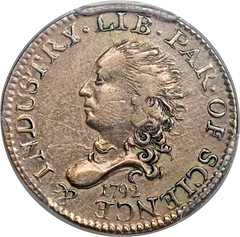 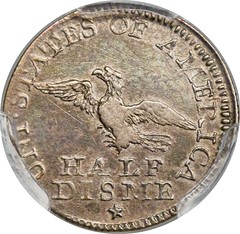
1792 H10C Half Disme, Judd-7, Pollock-7, R.4 XF40 PCGS Secure. More than 200 years of legend and myth surround the striking of the 1792 half dismes. A great deal of embellishment and outright fabrication seem to have been attached to these coins in the 1850s and 1860s. More than likely the greatest perpetuator of these legends and myths was Mint Director James Ross Snowden. Two of the more fanciful and widely held beliefs are that Martha Washington was the model for Liberty and the coins were struck from George and Martha Washington's silver tableware. In 2003, Joel Orosz and Carl Herkowitz separated much of the fact from fantasy regarding these coins in a well-researched article in the ANS' American Journal of Numismatics. Much of what we know today was based on an obscure tipped-in note found in a European coin book in 1943. The signature was faded, but the authors identified the author as John McAllister, Jr. McAllister was a close friend of Adam Eckfeldt, a primary source for the half dismes, as he was present at their striking. The note read: "In conversation with Mr. Adam Eckfeldt (Apr 9, 1844) at the Mint, he informed me that the Half Dismes above described, were struck, expressly for Gen. Washington, to the extent of One Hundred Dollars, which sum he deposited in Bullion or Coin, for the purpose. Mr. E. thinks that Gen. W. distributed them as presents. Some were sent to Europe, but the greater number, he believes, were given to friends of Gen. W. in Virginia. No more of them were ever coined. They were never designed as Currency. The Mint was not, at the time, fully ready for being put into operation. The Coining Machinery was in the cellar of Mr. Harper, saw maker, at the corner of Cherry and 6th Sts, at which place these pieces were struck." While half dismes were struck for "friends of Gen. W. in Virginia" many of them were used as currency at the time. This is obviously one of them.
A great example of an incredibly important coin in American numismatic history. Even if the eagle is kinda scrawny... -Editor
To read the complete lot description, see:
Lot 4157: 1795 Flowing Hair Dollar
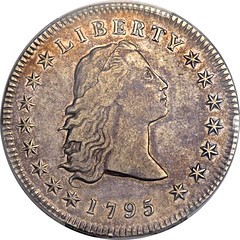 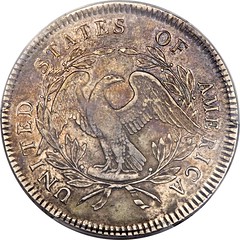
1795 $1 Flowing Hair, Three Leaves, B-5, BB-27, R.1, XF45 PCGS. The Flowing Hair silver dollar was struck for only two years, and since the 1794 is a costly rarity, most early type collectors instead select a 1795 example. Bolender-5 is easily attributed by the slender "bar" behind the highest neck curl, and represents the type in more holdings than any other Flowing Hair variety.
Nice example of a scarce early type. -Editor
To read the complete lot description, see:
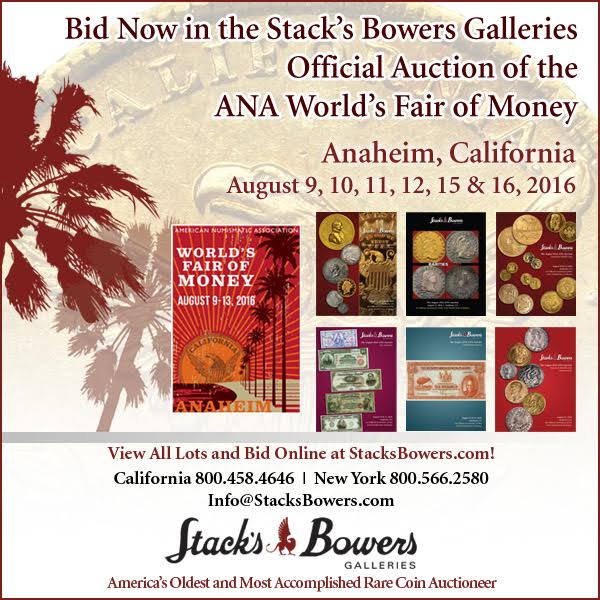
Wayne Homren, Editor The Numismatic Bibliomania Society is a non-profit organization promoting numismatic literature. See our web site at coinbooks.org. To submit items for publication in The E-Sylum, write to the Editor at this address: whomren@gmail.com To subscribe go to: https://my.binhost.com/lists/listinfo/esylum All Rights Reserved. NBS Home Page Contact the NBS webmaster 
|